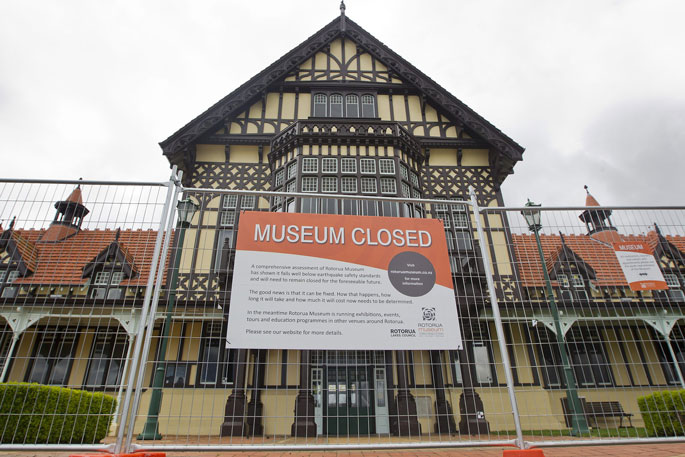Millions in Government funding will have to be paid back if Rotorua Lakes Council doesn’t finish its full museum restoration, despite big cost rises, a meeting has been told.
The council has come up with a potential way to pay the nearly $28 million needed to complete the troubled project, but uncertainties in the funding plan are making some elected officials nervous.
Mayor Tania Tapsell on Sunday described the Rotorua Museum restoration as “the most complex earthquake-strengthening project in the country” and said funding challenges reflected that.
The Category 1 heritage Bath House building housing the museum closed in 2016 after it was found to be earthquake-prone.
The restoration was originally expected to cost $53.85m, of which the council agreed to contribute $15.5m. It took out external funding contracts for the other $38.35m.
The full restoration, however, is now expected to cost at least $81.4m, leaving the council with a significant shortfall.
It is considering three options: fully restore and reopen the museum as planned, stretch the project out in stages or move the museum and find an alternative use for the heritage building.
The council met on Wednesday for its second workshop to inform the elected members ahead of their decision next month on which option to pursue.
They heard from Kānoa, the Ministry of Business, Innovation and Employment’s regional development arm and a major external funder of the project. It was formally known as the Provincial Growth Fund.
Kānoa regional development north director Portia McKenzie told the workshop Kānoa’s contract allowed it to fund up to $17m towards the restoration and reopening of the museum.
Its position was that if any other museum project options were chosen, the contract would be cancelled.
If the council chose to not go ahead with the full restoration, it would need to pay back at least $9.5m for the Government funding already received - $7m of the $10m received from Kānoa and $2.5m from the Regional Culture and Heritage Fund.
McKenzie said, however, potentially $5m more could be secured from Kānoa to continue the full restoration, as well as another $4m from the other government fund.
Kānoa funding totalling above $20m would need to be approved by Cabinet.
The workshop also heard updates about other external funders that may be willing to contribute more.
Rotorua Trust had committed $10m to the project and signalled another $5m could be added if the council continued with the full restoration and reopening.
Lottery Grants Board made commitments of $6m and $350,000 through its funds. Contracts would be cancelled under project alternatives, new applications would need to be made and the $2m already received be returned.
Those contributions, along with an application to the New Zealand Community Trust and pledges from private art collectors, if successful, could take the shortfall to about $11.95m.
This remainder could be covered by a possible Regional Infrastructure Fund the Bay of Plenty Regional Council was considering including in its Long Term Plan.
This would leave the district council needing to cover any extra costs uncovered when the project began.
Rotorua mayor Tania Tapsell said she had been trying to meet with Arts, Culture and Heritage Associate Minister Willow-Jean Prime to emphasise the importance of the project to the community.
“As a mayor and as a community we have already reached out and after a month and a half still haven’t managed to secure a meeting or response.”
A spokesperson for the minister told Local Democracy Reporting on Monday that the minister’s response to Tapsell’s correspondence had “been processed and will be sent this week”.
“The minister is aware of the issues raised and understands that ministry officials have already provided feedback and guidance to the Rotorua Museum project team.”
Earlier on Monday, Tapsell told Local Democracy Reporting the building was of national significance and she believed it should be a high priority for the Government.
She said both the council and funders needed certainty going forward and so staff had worked to get as much information from funders as possible and now the council needed to show clearly what it wanted to do with the building.
There was now a “level of negotiation” required, she said.
“This is the most complex earthquake-strengthening project in the country and challenges in funding have reflected that.”
A balanced decision, including community feedback, would be made, she said.
Speaking to councillors at Wednesday’s meeting, she explained her concerns.
“While we do have in front of us today a potential solution and potential funding, I still have great nervousness that this is only a potential.”
She said while it could approve the decision in August, there could still be a significant shortfall.
“I’m nervous we go, ‘yep, let’s go into this boots and all’, and someone decides, ‘well, actually nah, we’re not going to give you that money now’.”
Rotorua Lakes Council Te Arawa partnerships deputy chief executive Gina Rangi said while there was room for debt, there was no headroom for meeting both the funding gap and carrying residual risk above what was in the project’s contingency allowance.
She was confident there was a pathway but said the timing was challenging.
There would be more detail about risk management at the next workshop.
Chief executive Geoff Williams said there were elements working for the council; a lot of the funding was locked in through contracts.
“I think that system should give you a level of certainty that the base funding is actually firm.”
The additional Kānoa funding was where it became uncertain, he said.
Deputy mayor Sandra Kai Fong believed funding was the biggest risk. She said she was still nervous there was not certainty around “quite a significant gap”.
Public Interest Journalism funded through NZ On Air.




0 comments
Leave a Comment
You must be logged in to make a comment.